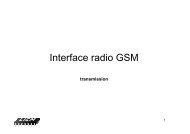Dependable Memory - Laboratoire Interface Capteurs ...
Dependable Memory - Laboratoire Interface Capteurs ...
Dependable Memory - Laboratoire Interface Capteurs ...
Create successful ePaper yourself
Turn your PDF publications into a flip-book with our unique Google optimized e-Paper software.
1.6. TECHNIQUES APPLIED AT DIFFERENT LEVELS 27<br />
Error Correction/Recovery<br />
Detecting an error is sufficient for providing safety, but we would also like the system to recover<br />
from the faulty states. Recovery hides the effects of the error from the user. After recovery, the system<br />
can resume operation and ideally remain live. Error recovery is an important feature for the system<br />
based on the two attributes of reliability and availability because both the metrics require the system<br />
to recover from its errors without user intervention.<br />
Error detection and recovery are addressed in this thesis, they will discussed in detail in the chap-<br />
ter 2. Similarly, various techniques of error detection (in section 2.1) and correction (in section 2.2)<br />
are also discussed.<br />
1.6 Techniques Applied at Different Levels<br />
Figure 1.11 illustrates the dependability techniques applied at different levels in a hardware and<br />
a software system in which fault avoidance (fault prevention) is the primary method to improve the<br />
system dependability. It may be taken into account through hardware or software implementations.<br />
The fault avoidance in a hardware based system can be achieved by preventing specification and<br />
implementation faults, component defects and external disturbances, while in a software based system<br />
it requires prevention of specification and implementation faults. On the other hand, fault masking is<br />
a technique used to ensure dependability, by masking the faults. TMR is a well-known example of<br />
this technique. If fault masking is not applied, then FT is a practical choice to overcome errors.<br />
1.6.1 FT Techniques<br />
Fault tolerant techniques for integrated circuits can be applied at different moments in the circuit<br />
design flow. They can be applied in the electrical design phase, such as transistor dimension, transistor<br />
redundancy and by adding electrical sensors. Some techniques can be added at logic design step, such<br />
as by adding hardware and time redundancy in the logic blocks and in the software application. The<br />
figure 1.12 is the further extension of previous discussed figure 1.2 . The figure represents different<br />
phases to tolerate faults (detect and correct). In each phase a different fault tolerant technique can be<br />
used. We are addressing the fault tolerant at hardware redundancy and self-checking level that are<br />
two higher levels (as shown in ‘c’ and ‘d’ of figure 1.12).<br />
1.7 Conclusions<br />
The goal of this chapter was to introduce the concepts of dependability in embedded systems. In<br />
fulfilling this objective, we have introduced the main issues related to the design and analysis of fault<br />
tolerant systems. Here, we have discussed different types of faults and their characteristics because



